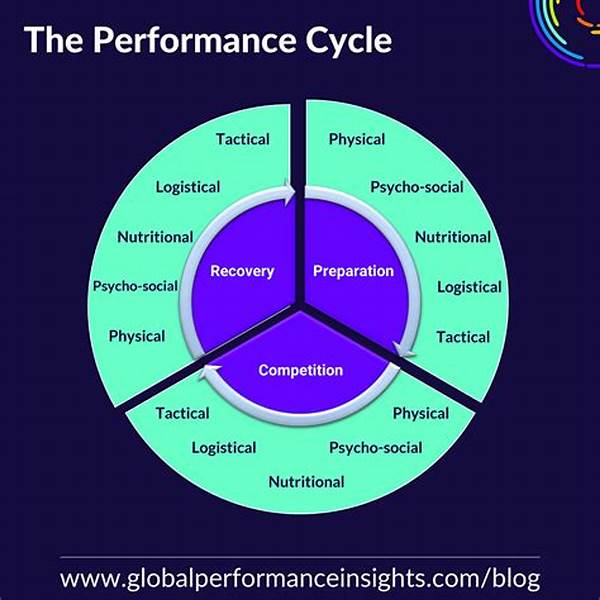The Science Of Recovery In High-performance Sports

The Science of Recovery in High-Performance Sports
Read More : Significant Rule Changes In Football Over The Years
In the relentless world of high-performance sports, where every millisecond counts and competition is fierce, athletes are continually pushing the physical and mental boundaries to achieve greatness. But greatness isn’t solely built on hard training sessions, exhaustive practices, or seamless teamwork; it is also intricately woven through the fabric of recovery. Yes, recovery — the unsung hero in the epic saga of sports achievements. The science of recovery in high-performance sports has revolutionized how modern athletes train, perform, and sustain excellence over prolonged careers. So, why is recovery so essential, and how has science turned it into an indispensable part of sports strategy?
Think of recovery as the crucial pit stop in the blazing race towards victory. It’s not just a passive phase but an active period designed to restore, rejuvenate, and ready athletes for the next physical demand. Statistics show that those who prioritize recovery can reduce injury risk by up to 30%, thereby extending the lifespan of an athlete’s career. But that’s not all — recovery techniques have evolved through innovative technologies and research-backed methods to enhance performance. From cryotherapy to advanced nutritional plans, and even mental health strategies, the focus is now on a holistic approach. The science of recovery in high-performance sports includes understanding physiological markers, hormonal balance, and even genetic predispositions to tailor individualized recovery protocols. Not only does this optimize performance, but it also allows athletes to rise and perform consistently at their peak.
With customization and technological advancement at its core, recovery science is not a one-size-fits-all model. Each athlete is a unique combination of strengths, weaknesses, and specific needs. Imagine a basketball star reducing muscle fatigue through Normatec compression boots, or a marathon runner using mindfulness to regain mental sharpness post-race. This personalized approach ensures maximal restoration. But, let’s be real, in this fast-paced culture where we’re all impatiently waiting for ‘the next big thing,’ recovery doesn’t mean lounging around — it means smart, scientifically-backed actions to unleash one’s fullest potential when it matters most. After all, the real win is to be able to stand up, go back out there, and do it all over again, better and stronger. That’s the power of the science of recovery in high-performance sports!
Understanding Recovery: A Game-Changer
The evolution of sports recovery practices has fundamentally altered how we understand athletic performance, alongside the recognition that rest and repair are not mutually exclusive to progress. Scientific validation underscores their efficacy, promoting both physical and mental rejuvenation as key competitive edges. The journey into understanding recovery science isn’t just for elite athletes but offers lessons for anyone keen to optimize their personal fitness journey. After all, the secrets of the professional world often inspire amateurs and weekend warriors alike to battle their inner inertia with newfound zeal and an intelligent compass. The science of recovery in high-performance sports is not just an exclusive privilege; it’s a deep well of knowledge, freely accessible to transform, empower, and consistently push boundaries. Recognizing its significance might just turn today’s sports enthusiasts into tomorrow’s legends.
—The Purpose of Recovery in Sports
Recovery isn’t just a buzzword — it’s a vital component in the architecture of athletic success, that has swiftly gained traction in the last decades. But what makes recovery so essential in high-performance sports? The core purpose of recovery lies in its fundamental ability to enhance performance longevity, encourage faster recuperation, and prevent injuries. At its most basic level, recovery is about allowing the body the time to heal from the stresses it endures during intensive training and competition.
Consider a Formula 1 car — after each grueling race, it requires a thorough tune-up, inspection, and maintenance to ensure it performs at its best for the next race. Similarly, the human body, after rigorous physical exertion, demands attention, repair, and restoration. The science of recovery in high-performance sports doesn’t just focus on a single dimension; rather, it looks holistically at both the mental and physical aspects, providing a comprehensive strategy that nurtures the athlete.
The Dual Role: Physical and Mental Recovery
Physical recovery is often emphasized because of its immediate, observable effects. Think about muscle repair, reducing inflammation, and energy replenishment. These physiological processes are essential to maintaining peak performance. However, mental recovery plays an equally pivotal role. Sports at an elite level are as much a mental game as they are physical. The science of recovery in high-performance sports reveals how managing stress, ensuring cognitive engagement, and maintaining emotional stability are crucial in preventing burnout and sustaining an athlete’s mental resilience.
When athletes recover mentally, they regain their focus, clarity, and the competitive edge required to face their next challenge. Strategies such as mindfulness, visualization, and meditation have become powerful tools in the athlete’s recovery arsenal. This blend of physical and mental recovery processes underscores that true recovery is holistic and total, serving the complete well-being of an athlete.
The Impact on Performance and Career Longevity
One of the greatest benefits of the structured recovery process is its positive impact on an athlete’s performance. Through comprehensive recovery, the body can adapt better and more rapidly to the demands imposed on it, thus enhancing overall athletic performance. The science of recovery in high-performance sports demonstrates that when athletes rest, they come back stronger, often with improved skills and heightened capabilities.
Moreover, effective recovery can significantly prolong an athlete’s career. Injuries are part and parcel of any sport, but recovery can mitigate the adverse impacts of such mishaps. By adopting recovery strategies that emphasize injury prevention and successful rehabilitation, athletes can sustain long-term career progression. The insights drawn from recovery science ensure that athletes aren’t just playing to the best of their abilities but are also safeguarding the longevity of their careers.
The Future of Recovery in High-Performance Sports
Looking ahead, the future of recovery in high-performance sports is an exciting frontier, with technology playing a key role. From wearable devices that track vital statistics and recovery indicators to AI-driven personalized recovery plans, the horizon is dotted with a multitude of innovative possibilities. The science of recovery in high-performance sports is continually evolving, with new research constantly molding and shaping what we thought we knew.
This ongoing evolution is not merely the domain of the high-profile athletes and the teams behind them, but it is making its way to the everyday athlete and fitness enthusiast. As recovery techniques become more widely accessible and understood, there’s an open invitation for anyone to engage with this science, ensuring their own fitness journeys are both rewarding and sustainable. The ground-breaking work within recovery science is clearly here to stay, promising a brighter, more balanced future in the realm of sports.
Key Elements in Recovery Science
—Enhancing Recovery: Modern Techniques in High-Performance Sports
When we dive into the nuanced world of high-performance sports, the distinction between winners and others is often built on marginal gains, where recovery plays a pivotal role. Evolving beyond traditional methods, the cutting-edge innovations in recovery have transformed it from a passive retreat to an active engagement engineered for rejuvenating athletes post-strenuous activities. The science of recovery in high-performance sports now embodies advanced modalities and scientific methodologies confirmed through rigorous research and innovation.
The implementation of tools such as cryotherapy and hyperbaric oxygen treatment provides immediate and tangible benefits. Athletes like basketball ace LeBron James and tennis legend Serena Williams have publicly endorsed these recovery strategies as critical components in their training regimes. With deep tissue massages replaces more than just muscle stiffness; it’s also a reset button for mental peace and concentration. Recovery, as seen in today’s scopes, isn’t merely an antidote to fatigue, but an enhancer of efficiency and effectiveness on the field.
Read More : Sky Sports Football Presents Special Coverage Of Talented Young Players
Swiper scrolls through social media may casually showcase elite athletes immersed in aqua therapy or strapped to futuristic-looking devices, yet each represents a calculated effort to maximize recovery outputs. The amalgamation of tradition and technology, guided by the science of recovery in high-performance sports, seeks to address the myriad aspects of athlete restoration. From ensuring hydration at the cellular level to calibrating muscle tensions, biofeedback systems are steadily capturing data matrices that allow tailored recovery solutions.
Innovation isn’t confined within institutional walls but extends to bespoke personal routines crafted for athletes’ unique physiologies. It calls for creating recovery calenders as integral as training schedules. Thanks to state-of-the-art technology and rigorous analytics, we are moving towards an era where recovery is no longer treated as additional, but essential. The science of recovery in high-performance sports assures us that systematic, science-based recovery is the new frontier that athletes must conquer to sustain competitive superiority.
Key Techniques: Understanding Science-Based Recovery Strategies
—Discussion: The Continuous Evolution of Recovery in Sports
The narrative of recovery in sports is one that has continuously evolved, reflecting broader innovations within health and wellness. As we recognize the importance of comprehensive recovery protocols in sports performance, it’s interesting to see how perspectives have shifted over time. Initially, recovery was a simple rest period allowing athletes to regain their strength. Fast forward to the present, and it’s a scientifically curated, holistic process encompassing numerous facets of an athlete’s life, both physically and mentally.
The science of recovery in high-performance sports has moved towards personalization, driven by technological advances and deeper understanding of physiology. Today, athletes consult with a consortium of specialists, from nutritionists and physiotherapists to psychologists, crafting recovery plans as detailed and specific as their training regimes. In recent interviews, prominent athletes have shared how this targeted approach enhances their game, offering audiences a glimpse into the profound influence recovery strategies wield on performance.
As recovery science continues to expand, the boundary between athletic performance and human biotechnology narrows. Wearable technology and data analytics offer real-time insights into an athlete’s recovery needs, ensuring they optimize periods of inactivity into opportunities for improvement. The science of recovery in high-performance sports is no longer about passive recuperation but is viewed as a dynamic, integral element of any successful athletic career. This continuous evolution in recovery strategies is an exciting area, promising even greater achievements and perhaps redefining what’s deemed humanly possible in sports.
Embracing the Future: The Continuous Evolution in Recovery
The future of recovery in sports promises to be as dynamic as it is important. Personalized recovery plans are becoming the norm, and technology continues to play a crucial role in shaping the landscape of sports recovery. As advancements continue to improve athletic performance through more refined recovery methods, the emphasis on recovery is likely to become more personalized and precise.
Looking at contemporary trends, recovery can no longer be viewed as a luxury or secondary consideration. With more research validating various recovery methodologies, athletes and coaches alike are seeing the benefits of investing time and resources into comprehensive recovery plans. The science of recovery in high-performance sports will remain a key consideration as athletes continue to push the limits of what is possible.
—10 Tips for Maximizing Recovery in High-Performance Sports
Individualized Recovery Plans: A Key to Sustained Performance
Crafting an individualized recovery plan isn’t just about tailoring physical exercises to fit an athlete’s current condition. It’s also about acknowledging their mental and emotional states. Recognizing that no two athletes are the same, recovery programs must reflect not only their physical requirements but also their psychological needs.
Moreover, the role of coaches and sports scientists is critical in creating these customized plans. These professionals must ensure that each aspect of recovery is meticulously aligned with the athlete’s overall performance goals. With technology enabling precise monitoring and data collection, athletes can now receive instant feedback on their recovery progress, making adjustments more fluid and effective. This personalization is at the core of the science of recovery in high-performance sports, ensuring athletes don’t just compete — they triumph sustainably.
Technology’s Role in Shaping Modern Recovery Practices
Advanced technology now enables athletes to receive targeted recovery treatments. Wearables provide precise insights into health metrics, directing focus on areas requiring recovery attention. AI algorithms identify patterns and project recovery timelines, fine-tuning strategies further in real time.
With virtual reality offering mental rest through immersive environments, athletes can engage in cognitive relief and relaxation sooner and more effectively. As technology advances, we anticipate even greater precision in recovery, enabling athletes to reach new heights in performance previously thought unattainable. The science of recovery in high-performance sports is set on a path to redefine our limits, pushing the envelope of what is possible.
Building a Future with the Science of Recovery in High-Performance Sports
The solutions presented by recovery science are not just transient fixes but long-term enhancements that redefine athletes’ lives. Through meticulous monitoring, scientific innovation, and personal insights, recovery becomes not only a necessary pause but a gateway to heightened performance and well-being. As we probe deeper into the compounded effects of strategic recovery, the potential for using this science to expand human performance becomes firmly within reach. The realm of sports has always been about surpassing boundaries; the science of recovery in high-performance sports ensures these boundaries are pushed sustainably.



